How To Make Hardtack
Today I want to show you how to make hardtack (aka hard tack). You may wonder what it is, I get it. It’s basically a biscuit of sorts or unleavened bread baked until there is zero moisture in it. The dictionary describes hardtack as a dry bread or biscuit used as rations for sailors.
It has also been called by other names like sea biscuit, ship biscuit, pilot bread, sea bread, and pilot biscuit. Due to its dry nature, it could be stored for long periods without any need for refrigeration.
Besides sailors, others like soldiers, pioneers, early settlers, miners, and adventurers have been using this special food for a long time. They did so, not just to get nourishment, but to survive, in many cases. It has been a popular food option for centuries. This is a good food to have on hand because it lasts for a very long time when stored properly.
It’s a hard cracker that is made from water, salt, and flour. Don’t plan to add other ingredients like butter or vegetable oil since that will reduce the time it can be safely stored.
Some people will add spices like ground black pepper, rosemary, or some Italian seasoning in place of some of the salt as a means to add flavor since it tends to taste pretty bland.
Those seasonings could also reduce the long-term storage capacity, so think before you add them if you are looking for the longest possible storage periods. Keep reading to discover how to make this food storage standby.
I’ve had so many of my readers ask questions and make comments about this hardtack recipe that I decided to update the information and publish it again. Enjoy!
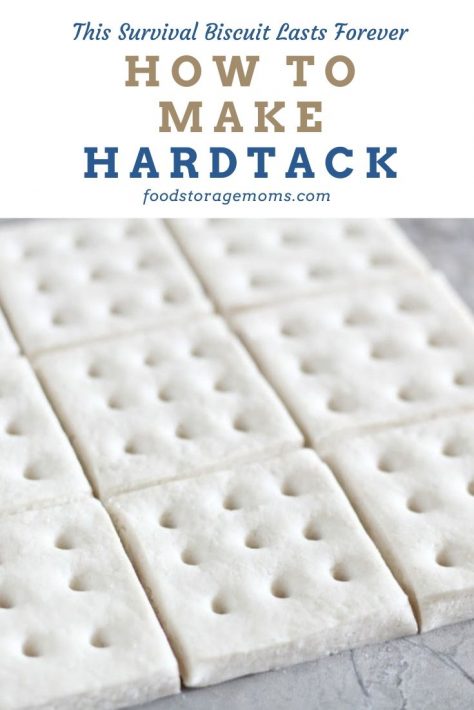
Where Did Hardtack Originate?
Hardtack goes way back before you or I were born. In 1801, Joseph Bent created the cracker. However, hardtack originated in the U.S. in Newburyport, MA. As you can imagine, this type of cracker was taken on long voyages and Newburyport was a busy port city and home to many sailing ships.
I was recently introduced to the term “Roman Hardtack.” In ancient histories, the term “Bucellatum” was used to describe food used by the troops of the Roman Empire that equates to their version of hardtack. It may date as far back as 360 AD. This hardtack was made from flour, salt, and water, just like it is now. They would also have wine and possibly some bacon from time to time as additional items during a meal. It’s hard to imagine a food product we have now would have originated that long ago. They enjoyed it for the same reason we do, few ingredients, easy to make, and lasts a long time.
It’s safe to say that Hardtack has been around for a while. You can read more about the history of hardtack here.
Others will tell you that hardtack was created during the Civil War. There is even evidence that a type of “hardtack” went all the way back to Egyptian times. It’s safe to say that there have been many versions of hardtack being used since early civilization.
Kitchen Tools You’ll Need:
- Medium mixing bowl
- Sharp knife
- Baking sheet
- Nail or a dough docker
3 Ingredients-That’s It:
- White flour: best used rather than wheat flour; wheat flour has oils that could draw moisture into the product leading to a chance of spoilage.
- Salt: an added preservative and also adds a bit of flavor to the hardtack.
- Water: adding water to the white flour and salt mixture helps to create the dough needed to make the hardtack.
How To Make Hardtack
Step One: Combine Flour, Salt, and Water
Combine the flour, salt, and water in a bowl.
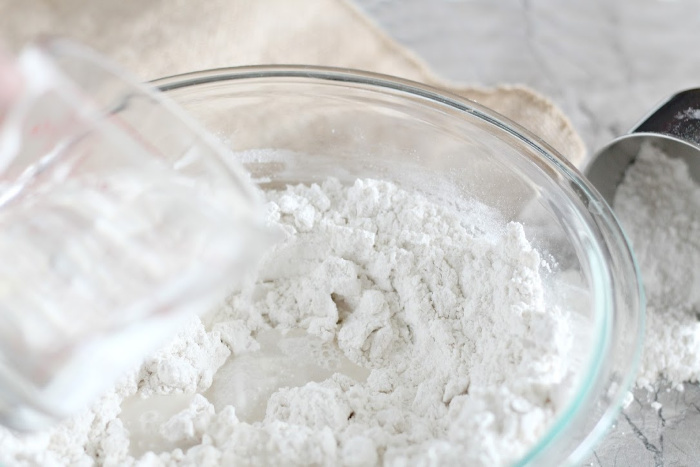
Step Two: First Mix and then Knead the Dough
After mixing, scoop the dough onto a floured countertop. The dough will be sticky at first. Knead until mixed thoroughly.
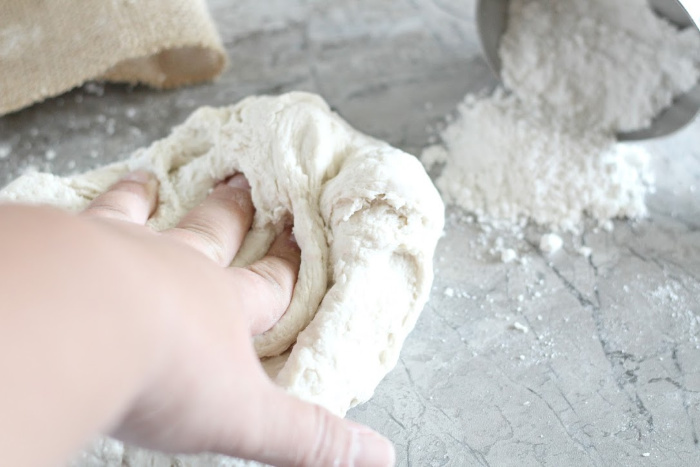
Step Three: Roll the Dough and Cut it into Squares
With a rolling pin, roll the dough out so it’s about 1/2 inch thick and forms into a rectangular shape. Use a sharp knife to cut the sections evenly about 3-inches apart. I used a ruler to keep them square.
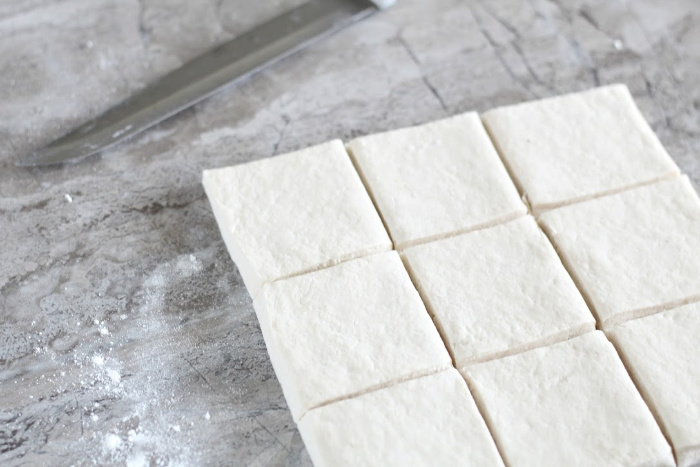
Step Four: Poke Holes
Use a nail or something with a sharp point to poke holes as shown. Some people poke both sides, I didn’t with this recipe.
The holes are put in the hardtack so air pockets don’t form in the cracker during the cooking process, thus keeping it consistently formed in the same shape.
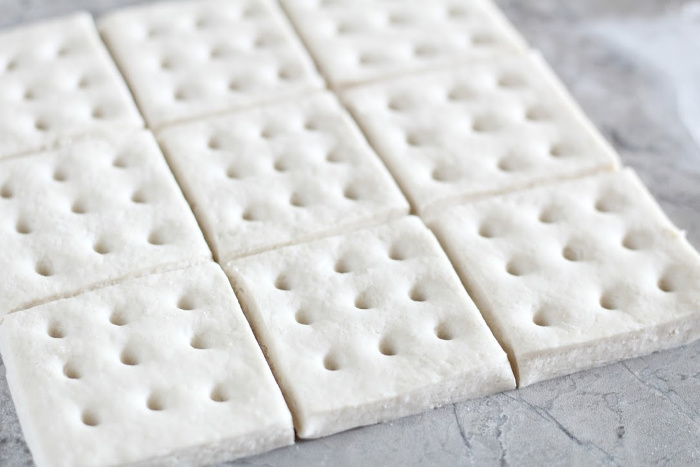
Step Five: Bake for 30 minutes on Each Side
Preheat the oven to (375°F) = (190°C) degrees. Place the hardtack pieces on an ungreased cookie sheet and bake one side for 30 minutes. After 30 minutes turn the hardtack over and cook the other side for an additional 30 minutes.
Set the cookie sheet on a cooling rack after baking until the hardtack has cooled.
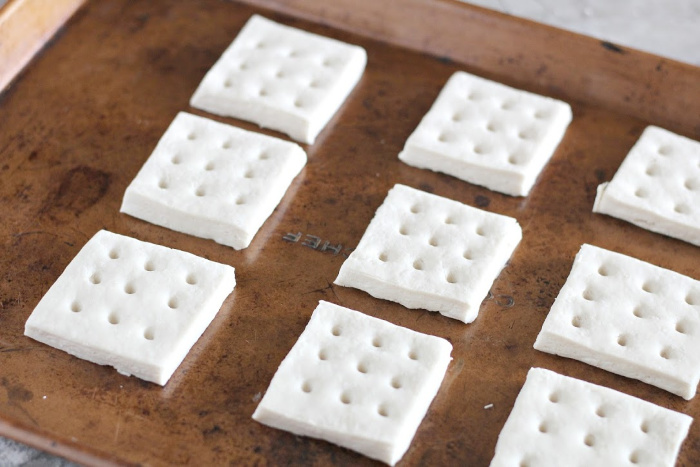
Step Six: Cool and Store
After it cools, it’s ready to store in airtight containers.
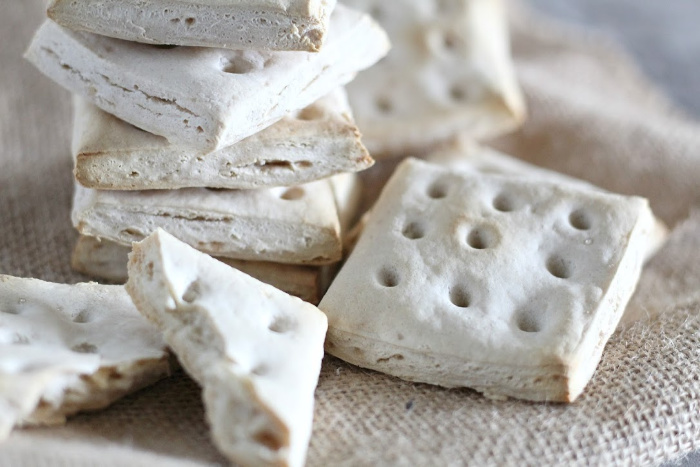
How Do You Store Hardtack?
A lot of people would think that hardtack is hard to store, but it’s not. It’s very simple! Because of the way it’s made, hardtack can be stored for a very long time, up to 50 years. Grains typically have a long shelf life and it comes in handy when fresh food isn’t available. Hardtack is a great survival food!
Note that some people have made hardtack using oil in the recipe, or on the sheet when cooked. If that is the case, the hardtack likely won’t last nearly as long since the oil is prone to go rancid over time.
I recommend using mason jars that you can seal very tightly or sealed airtight using your Seal A Meal unit to vacuum seal the hardtack. Just make sure that the hardtack has cooled and isn’t exposed to humid air since it could then go bad.
Here’s the deal, you can make a batch and then store it, then repeat when you have time. You will never have to buy what I call “forever crackers” because YOU can make them.
What Do You Serve With Hardtack?
Here’s the fun part. You may be wondering HOW to serve hardtack. Back in the day, you would soften it with water or coffee. You can serve it with almost anything, but your favorite liquid is best.
Do you remember Grandma eating bread and milk? Mark’s parents would have bread and milk every Sunday night. They would grab a bowl filled with milk and place bits of bread in it.
Mark’s parents would eat it with cheese. You could soak hardtack in milk and eat it just like they did.
Just add some cheese, jam, honey, meat, salt, and black pepper, or anything else your stomach desires. Some may enjoy eating it with soda or beer. You can eat it by itself. However, it’s recommended that you soak it in something liquid prior to eating since the name includes the word “hard.” Be careful! Many people have reported tooth damage from eating hardtack without softening it first. Hardtack crackers have been known as “tooth dullers,” “molar breakers,” and “sheet iron crackers.” Back in the day, behind the back of cooks who would serve it to sailors, explorers, or the like, many would call it “dog biscuits” because it wouldn’t necessarily have been their first choice of food. Please soften before eating!
Does Hardtack Stay Hard Forever?
The unique thing about hardtack is that it will stay hard forever. It will last forever because it is only made with three ingredients. If you are able to keep it dry, it could literally last forever.
It’ll stay good even through extreme temps. If you are looking for something to store, hardtack is something to make in case of an emergency. At least you know you will always have food.
How Long Is The Shelf-Life of Hardtack?
Some experts say that it can be stored for up to 50 years. As long as it doesn’t get wet and hasn’t had spoilable ingredients added, it can last through anything. Only soak it if you are ready to eat it. Remember, it’s like a cracker, only way harder.
Soup is Perfect with Hardtack
Hardtack Recipe
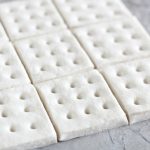
- 3 cups white flour
- 2 teaspoons salt
- 1 cup water
-
1. Combine the flour, salt, and water in a bowl.
2. After mixing, scoop the dough onto a floured countertop. The dough will be sticky at first. Knead until mixed thoroughly.
3. With a rolling pin, roll the dough out about 1/2 inch thick into a rectangular shape. Use a sharp knife to cut the sections evenly about 3-inches apart. I used a ruler to keep them square.
4. Use a nail or something with a sharp point to make the holes.
5. Preheat the oven to (375°F) = (190°C) degrees. Place the hardtack pieces on an ungreased cookie sheet and bake one side for 30 minutes. After 30 minutes turn the hardtack over and cook the other side for an additional 30 minutes. Set the cookie sheet on a cooling rack after baking until cool.
6. After it cools, it's ready to store in airtight containers.
Can I use wheat flour to make hardtack?
The problem with whole wheat flour is that it will go rancid sooner, so I would not use it for this recipe if you’re planning to make it for longer-term storage. If your family enjoys this special cracker-like product and you plan to eat it often, then I’d try the wheat flour and enjoy it in the short term.
Does hardtack have any nutritional value?
Hardtack is made with white flour which is high in calories and carbohydrates. It would help to provide the energy your body would need in a time of survival or strenuous labor. Hardtack can be viewed as survival food. Adding hardtack to items such as milk or soup would help to add more nutritional content such as vitamins and grams of protein to a snack or meal.
Final Word
I really believe we need to know how to make hardtack, along with tortillas, bread, biscuits, and pasta. It fills the belly, and when a disaster hits, we may need to make it to get through the ordeal, I promise.
Please let me know what you usually use as your favorite liquid companion when you eat your hardtack. I think mine is clam chowder! Thanks for being prepared for the unexpected. May God bless this world, Linda


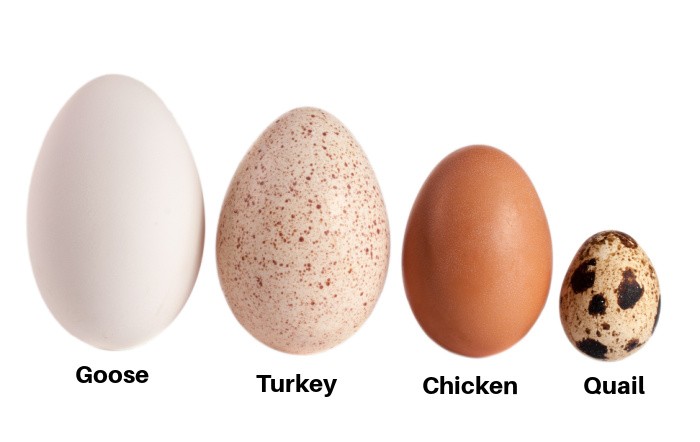
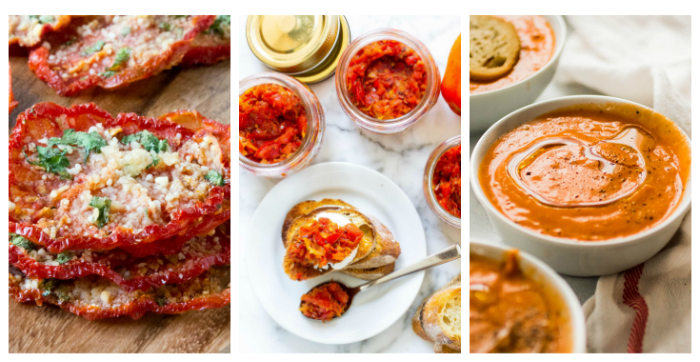

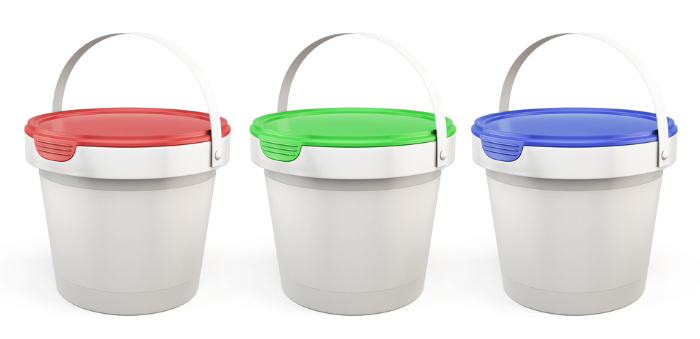
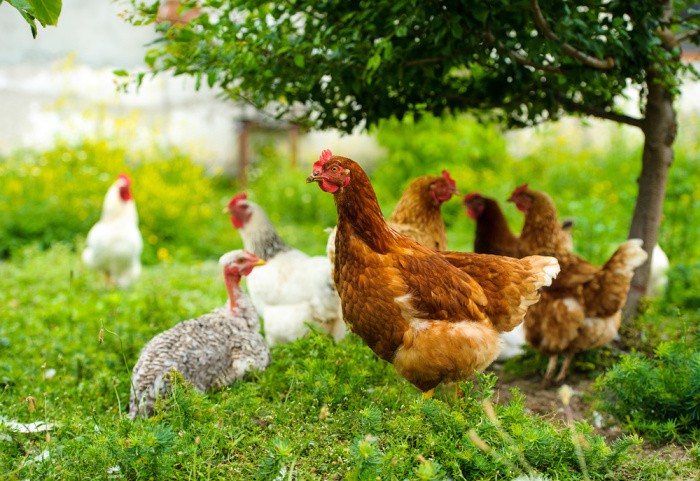
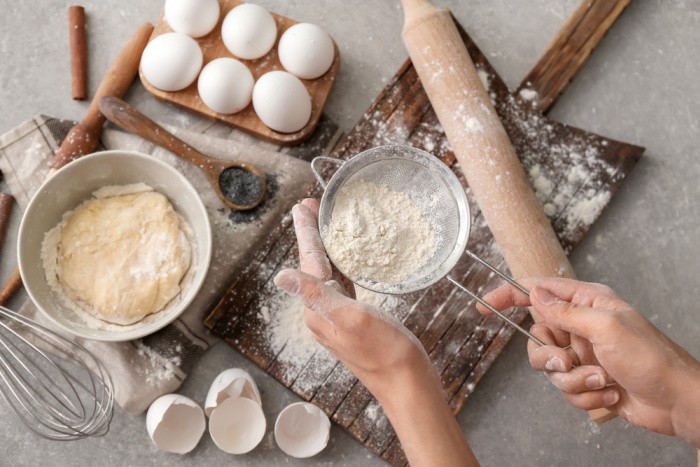
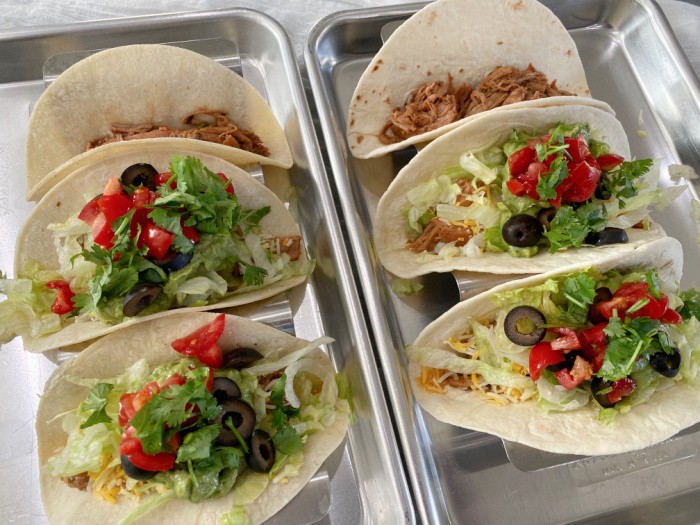

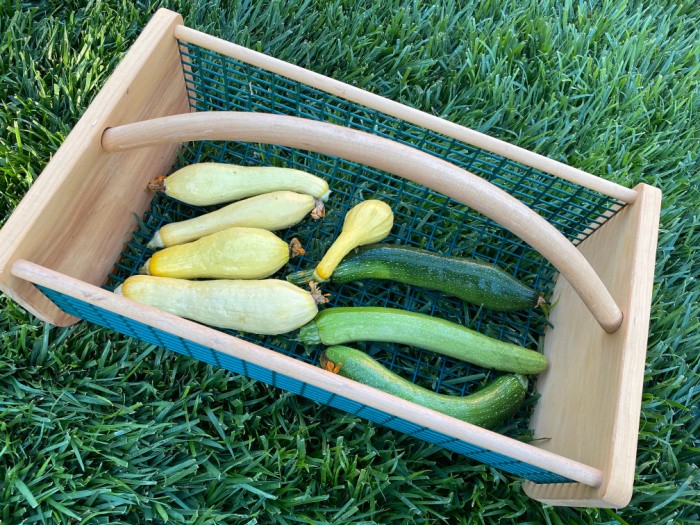
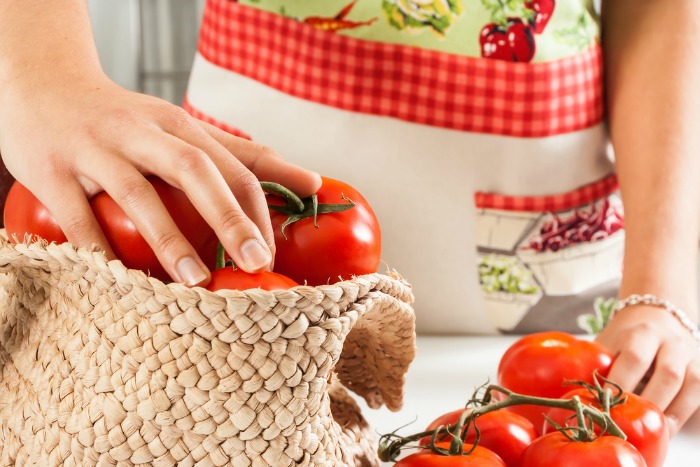
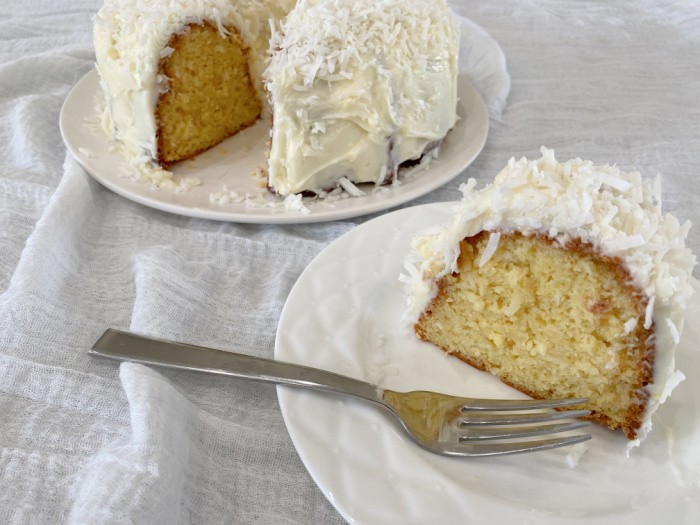








I always wondered about that stuff, just not enough to research it. I have a question, though. What if you have gluten issues? I don’t have Celiac’s, but I do get a mild allergic response akin to stuffy nose after eating gluten-containing foods, including rice. Would there be an acceptable alternative to wheat flour?
Hi Terry, that’s a very good question. My concern would be the shelf life of all other flours. I wish I could answer that but it’s frustrating to me about the gluten-free flour shelf-life. They have about 6 months, that’s not going to work for my food storage stash. Linda
Thanks for the info. I keep hoping something better will become available for those of us with allergies. Salt content is also an issue. Salt is such a terrific and inexpensive preserver that many longterm food supplies are heavy on salt. Limited diets will be even more limited in a disaster, so we need to plan especially carefully.
Hi Terry, you are so right, on the salt. Linda
Can hardtack be made from almond flour?
Hi Gail, possibly for short term storage but it’s made from almonds so the shelf-life would be short-lived. Almond flour is different than white flour, obviously. But you could try, it’s just that almond flour is so expensive. Linda
Most stuck to my wire rack so I think I’ll grease it with olive oil next time. Used a little seasoning; Cayenne pepper, cinnamon, basil, and pepper w/ salt. Not much but it gives it a subtle spice.
Very simple, stored in zip lock bags for future use.
Hi Johnny, great, thanks for the tips on the seasonings! Linda
Cookie sheets work best. Turn them half way through. Store them with musket, balls and powder.
Hi Linda.
Love the idea of hard tack. Can I store it in vacuum seal bags? If so, would you use oxygen absorbers?
Thanks
Hi Mary Jane, I suppose you could use oxygen absorbers in vacuum-sealed bags. I store mine in mason jars sealed with my FoodSaver without oxygen absorbers. Linda
I read somewhere that hard tack can be ground and used as flour in other recipes. This way flour will never go bad. A long term way to store flour.
Hi Mary, oh my gosh, this makes total sense. I love hearing this tip!! Thank you so much, Linda
My experience with Hardtack – pre-Y2k I made a big batch using essentially the recipe/steps above.
The first day after baking it was in my mind not hard so I did a 180 degrees for about 4 hours. Then it was hard.
I put the tack in several quart sized Ziplock freezer bags and put them on the guest bedroom closet shelf.
at:
1 week – tried part of 1 no issues.
2 week – tried part of 1 no issues.
1 month – tried part of 1 no issues.
2 month – tried part of 1 no issues.
3 month – tried part of 1 no issues.
6 month – tried part of 1 no issues.
12, 18, 24, 36 month – tried part of 1 no issues.
A friends step-son was in a Civil War reenactor group. I gave them the rest if my now 4 year old batch – no issues.
They had me come to a meeting, we cooked a big batch, and they have continued to cook/store/eat it since.
The friends step-son wound up a machine gunner in Afghanistan. I sent a #10 can of Pilot Bread, 3 large jars of Peanut Butter, 6 large jars of Jam, 6 one quart baggies of Hardtack, a 1 quart plastic container of hardened bacon fat labeled “WolfBrother’s Country Spread”, and 2 Sam’s size containers of beef and chicken bouillon cubes.
I got back an signed by all picture of his squad and a huge thanks from them saying the hardtack and “country spread” were the best of the bunch. And then several letters from their wives/parents asking for the hardtack recipe.
Your recipe above, as I noted before, is essentially the one I used. I used the one from Bent’s Bakery in Milton, Massachusetts. From 1801 until 2013 when it sold the family owned business worked as a bakery and was a prime supplier of hardtack during the Civil War, the westward expansion, and Spanish-American war.
Hi WolfBrother, Oh how I love your comment! Thank you for sharing this story about your friend’s stepson!! I love hearing how long the hardtack lasted for you AND what you sent over to Afghanistan!! Thank you so much!! Linda
Linda ~
I think this is something I would do right about the time my flour is at its “best by date”!!
I have also seen recipes that used beef broth to flavor the hardtack. Might not have the same shelf life, however.
Another thing you can do with hardtack is take some broth from your soup or stew and bring it to a boil, add hardtack and cover to let it soften. Might have a dumpling like consistency then. And it would take on the flavor of the soup or stew.
Hi Leanne, I agree the beef broth has fat and they would spoil. BUT, I’m going to go add soup to the post for dipping the hardtack in, great tip! Linda
Linda I was wondering if you can add sugar, being sugar is shelf stable as well?
Hi Judith, I think the idea behind the hardtack is that it’s a cracker of sorts. I would think adding sugar would change the “chemistry” of the hardtack. That’s my concern about mold or bacteria growth. I would add whatever you want to the “meal” when you use the hardtack. NOW, if you are making it for short-term storage that’s a different story. You could store them in the freezer or frig if you add sugar, honey, or oil. Then it’s not really hardtack but a cracker. Does that make sense? Eother way it’s a great way to help stretch our grocery budget. Linda
Linda, would other flours such as whole wheat, almond, rice etc work as well?
Hi Jan, I think any flour would work for short term storage. I would try a small batch and then freeze them. We know white flour lasts indefinitely in this hardtack recipe, it’s hard to say on the other flours. They have such a short shelf-life compared to white flour. Linda
Jan, let me be clear on what I said earlier, white flour in hardtack lasts indefinitely. White flour only has a shelf life of 9-12 months. Linda
I see the ingredients but I don’t see the ratios. How much of each ingredient do you use?
Hi Kathleen, no worries. Linda
Disregard.
Can I make this without Salt? I recently had a heart attack, and really have to watch sodium intake.
Thank you.
Hi Jewel, I’m sorry to hear about your heart attack, wow! What I do know is that salt helps “bind” a recipe together and is somewhat of a preservative. You can always try making it without. Linda
I just made these and they turned out so delicious!
Hi Alli, I’m so happy to hear this!! It’s a great preparedness item! Linda
I’ve been wanting to make this, thank you.
Hi Tiffany, it’s a great preparedness item! Linda
What a great way to store food long term! 50 years?! Wow! I’m making some tonight. Planning to store in mason jars. Thank you sooo much!❤️
Hi Camille, it truly is a remarkable recipe for the preparedness groups. It’s wonderful in soups! Linda
I have been looking for something to prep that isn’t very costly. I can’t believe how long these “crackers” can last!
Hi Jess, these hardtack crackers are the best and so easy to make. They are great in soup! Linda
This is great and so simple!
Hi Ashley, it will be the best recipe for your family to survive! Linda
Re the Origin of Hardtack, it goes back farther than 1801.
Google ancient Roman “buccellatum”.
Hi IAC, thank you for the heads up! I will do that! I love it! Linda
My team and I made hardtack a few years ago. We used the oven, smoker and even the bbq grill to cook it off. We had quite the production assembly line going.
We stored it in Mylar.
You must make sure it is COMPLETELY cooled before storing. That’s the biggest mistake made by folks because it is time consuming.
I made a mistake in not placing the Mylar bags in a plastic container and a mouse chewed into several of them.
It is a perfect way to use older flour that is coming up on its date.
Hi Matt, those darn mice!! Having a team would be awesome to make a lot of it. I can almost visualize all of you lined up, oh how I love this! Great reminder on making sure it’s completely cooled before preparing for storage. Good one. Linda
Linda,
I had never considered making hardtack until now so thanks for the idea. I printed out the recipe.
Add a desiccant pack to the mason jars if you can’t vacuum seal them. That should keep them from drawing moisture.
Love that comment from Mary in mn on hardtack being converted to flour. Great idea.
We are currently using white flour I stored in Mylar bags with O2 absorbers four years ago with no issues at all.
HI Ray, that’s awesome about the flour, we all know there is going to be a shortage of flour, rice, and potatoes. If there was ever a time to believe in shortages it is now. I hope people understand what’s going on. The drought here in the US and around the world is only one of the issues. You know exactly what I’m saying. We must stock up. Linda
Linda,
Local stores are “rationing” canning jar purchases to at most two cases per visit. So, every time I go I’m picking up two cases of Quart-sized Wide Mouth Mason Jars and extra wide mouth lids.
I haven’t tried it yet but am thinking that vacuum sealing white flour in such jars would be a very good way to preserve it. Plus I’m using those jars with O2 absorbers to store pasta long term–and any jars not currently being used for anything else I’m using to store water.
Jane loves Pearl Milling Company’s (formerly Aunt Jemima before the woke crowd acted up) pancake mix you have to add oil, milk and egg to–so we have that stored in quart mason jars with O2 absorbers as well.
Unless you live in earthquake country, mason jars are the best way to store dry goods, mainly because they are even easier to use than Mylar bags.
Hi Ray, I would grab those jars for sure. I have seen the jars here, no limit (yet) but zero canning lids. Yeah, I live in an earthquake area. But I do use jar containers for most of my empty jars. They used to be called JarBox made by Jeri out of Wyoming. It looks like she may have sold the company because Scheels sells them. Plus a few other companies. I wrote this post back in 2015. It needs some work. LOL! Linda https://www.foodstoragemoms.com/safely-store-mason-jars-today/
Ray, this is her website: https://www.jarbox.com/product/jarbox-quart/
Perfect time to post this recipe.
Hi Frank, you are always so kind, thank you my friend, Linda
Why no leavening? A cracker or pilot bread leavened with baking soda has a shelf life just as long as one without – and won’t break your teeth.
Hi Matt, hardtack is what it is, hard. You can add a leavening if choose to do so. If it’s baked with the three ingredients I used it should last a very long time. It’s designed to dip in coffee, hot chocolate, or in soup. This is my favorite recipe I have used for over 50 years, it has served my family well. LInda
I had several relatives that fought in the Civil War on both sides, all were from Kentucky, which was a very split state, many fought for both sides. I had a Great Grandma that I got to meet when I was very young in the 1960’s, she passed on a letter that had been handed down to her over the years from the Wife of one of our Civil War relatives, my Mom ended up with the letter & passed it on to me, I’m now 63. The letter was sent from the battlefield which was not mentioned, he just said he believed they were somewhere in Tennessee, & discusses many things, but he got to the food, told his Wife what he was eating, he mentioned the hard tack, he called it Iron Crackers, he told her he was eating Iron crackers nearly every meal, & that they were breaking teeth in many men in his unit, they tried dipping in Coffee, Milk & doing other things, nothing worked, he said finally 1 man cooked up some bacon & dropped his cracker or hard tack he was eating into the hot grease, he got it out & after it cooled off he tried a bite & it bit right off, he said the inside was soft & the outside no longer hard like hard, they could bite & chew & eat it, he said from then on everyone began basically frying their hard tack in Bacon grease, fat whatever they had which were all staples in many units. I’ve tried it myself & it’s exactly described in his letter, frying for a minute or 2 maybe at most in oil, bacon grease whatever makes the outside crunchy but takes away the hardness & inside is softer & you can eat as is & the bacon grease gives it very good flavor.
Hi Rob, thank you for the 5 stars, my friend! Oh, I LOVE LOVE LOVE your comment. I love hearing family stories, boy that was terrible about how the hard tack broke teeth!!! The bacon grease is a great idea. I have only heard you have to put them in soup because otherwise they would never break up so we could eat them. I had heard about dipping them in coffee, but soup is the only thing that workds for me. Now I have to try the bacon grease, great tip!! You are so lucky to have those letters, what a treasure. Linda